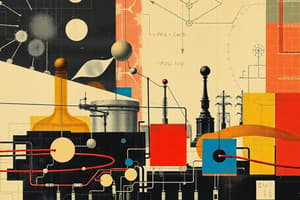Podcast
Questions and Answers
What is a key characteristic of a conductor?
What is a key characteristic of a conductor?
- Allows the flow of electric current (correct)
- Has high resistance to electrical flow
- Has a very low melting point
- Is often non-metallic
Which of these materials is typically used as an insulator?
Which of these materials is typically used as an insulator?
- Rubber (correct)
- Copper
- Aluminum
- Silver
What is the primary function of electrical resistance?
What is the primary function of electrical resistance?
- To decrease the power consumption
- To increase the flow of electricity
- To transfer electrical energy efficiently
- To oppose the flow of electric current (correct)
What does a semiconductor typically do?
What does a semiconductor typically do?
Which combination of materials is likely to function as a conductor?
Which combination of materials is likely to function as a conductor?
What is the primary function of a diode?
What is the primary function of a diode?
Which of the following components is known for opposing changes in current?
Which of the following components is known for opposing changes in current?
What characteristic of a diode allows it to block current in one direction?
What characteristic of a diode allows it to block current in one direction?
In context of electrical components, what does reluctance refer to?
In context of electrical components, what does reluctance refer to?
Which of the following components provides a path for electrical current with minimal resistance?
Which of the following components provides a path for electrical current with minimal resistance?
What type of current does a diode primarily rectify?
What type of current does a diode primarily rectify?
What is indicated by the resistors in a circuit?
What is indicated by the resistors in a circuit?
How does an inductor affect the current in a circuit?
How does an inductor affect the current in a circuit?
What is the primary function of a circuit diagram?
What is the primary function of a circuit diagram?
What could an increase in resistance in a circuit lead to?
What could an increase in resistance in a circuit lead to?
Which component is crucial for allowing electric current to flow in a specific direction and block it in the opposite direction?
Which component is crucial for allowing electric current to flow in a specific direction and block it in the opposite direction?
What factor is NOT typically relevant in analyzing a resistor's performance?
What factor is NOT typically relevant in analyzing a resistor's performance?
What does the color code on a resistor indicate?
What does the color code on a resistor indicate?
Which type of resistance measurement is commonly used to evaluate a circuit?
Which type of resistance measurement is commonly used to evaluate a circuit?
What does a resistor convert electrical energy into?
What does a resistor convert electrical energy into?
What role does a resistor play in an electric circuit?
What role does a resistor play in an electric circuit?
What is indicated by the bond value in a capacitor?
What is indicated by the bond value in a capacitor?
Which type of capacitors typically holds electrical energy?
Which type of capacitors typically holds electrical energy?
How does capacitance in capacitors relate to materials used?
How does capacitance in capacitors relate to materials used?
What distinguishes electrolytic capacitors from other types?
What distinguishes electrolytic capacitors from other types?
In what scenario would a dielectric material be critical for a capacitor's operation?
In what scenario would a dielectric material be critical for a capacitor's operation?
Which of the following statements about capacitors is true?
Which of the following statements about capacitors is true?
What is a common application for capacitors in electronic circuits?
What is a common application for capacitors in electronic circuits?
Which property must be maintained to prevent damage to electrolytic capacitors?
Which property must be maintained to prevent damage to electrolytic capacitors?
Flashcards are hidden until you start studying
Study Notes
Electronic Components Overview
- Resistors control current flow, measured in ohms and indicated by color codes; tolerance is also a key characteristic.
- Capacitors store electrical energy, with variants like ceramic, electrolytic, and tantalum, identified by their type codes and capacitance values.
- Inductors resist changes in current, characterized by inductance, measured in henries, and also identified by color codes.
Resistors
- Resistance values are denoted using a color code system to indicate their value and tolerance.
- Common resistor color codes involve bands that correspond to numerical values.
- Familiarity with types and specifications of resistors is essential for circuit design.
Capacitors
- Two main types: polar (like electrolytic) and non-polar (like ceramic).
- Capacitance measured in farads, determining how much charge the capacitor can hold.
- Important to recognize dielectric types (ceramic, electrolytic) as well as voltage ratings for safe usage.
Inductors
- Function by storing energy in a magnetic field created when current flows through the coil.
- Inductance, measured in henries, describes an inductor's ability to store this energy.
- The performance is affected by material and number of turns in the coil.
Diodes
- Diodes allow current to flow in one direction only, serving critical roles in converting alternating current (AC) to direct current (DC).
- Identified with color codes depicting their voltage and current ratings; commonly used for rectification in circuits.
Color Coding System
- Resistors and capacitors utilize color coding to easily identify their values.
- For resistors, the first two or three bands represent significant digits, while the last band indicates tolerance.
- Capacitors marked with numerical codes corresponding to capacitance values and voltage ratings.
Circuit Design Fundamentals
- Understanding of components is vital for creating reliable electronic circuits.
- Components should be selected based on their characteristics and how they interact within the circuit context.
- Proper identification and implementation of components influence circuit functionality and safety.
Testing and Measurement
- Various methods are employed to test components, including ohmmeters for resistance, capacitance meters for capacitors, and inductance meters for inductors.
- Recognition of symbols and proper techniques is crucial when reading circuit diagrams or schematics.
Safety Considerations
- Always adhere to voltage ratings and polarities when working with components to avoid damage or hazards.
- Overloading components can lead to failure or even catastrophic events, so understanding specifications is important.
Practical Applications
- Diodes are essential in power supplies for converting AC to DC.
- Capacitors can smooth out voltage fluctuations in power supplies.
- Inductors are commonly used in filters and power supplies to regulate current flow.
Studying That Suits You
Use AI to generate personalized quizzes and flashcards to suit your learning preferences.





